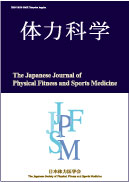
- Issue 2 Pages 63-
- Issue 1 Pages 1-
- |<
- <
- 1
- >
- >|
-
Masaki Yoshioka, Misato Takada, Makinori Matsuo, Seiji Maeda, Keisei K ...Article type: Original
2024 Volume 73 Issue 2 Pages 63-74
Published: April 01, 2024
Released on J-STAGE: March 13, 2024
JOURNAL OPEN ACCESS
Supplementary materialThe mood and sleep status influence subsequent physical performance. However, the relationship between these factors and the accuracy of hitting the mark in kyudo remains unexplored. This study aimed to compare the mood and sleep status of university kyudo athletes on days with higher and lower accuracy. A total of 15 university kyudo athletes (age, 20 ± 2 years; 11 men) participated in the study. Participants were instructed to shoot 20 arrows in the morning for two to three days, with the days of higher and lower accuracy subsequently determined and compared for mood and sleep status. Sleep status on the preceding day of the accuracy assessments was measured using the Nemuri SCAN, while mood status immediately before the accuracy assessments were measured using the Profile of Mood States 2nd Edition (POMS2). None of the study participants demonstrated consistent accuracy across all accuracy assessments. When a three-day accuracy assessment was administered, and consistent accuracy was demonstrated on two days, the average mood and sleep status from those two days were incorporated into the analysis. Results indicated that total sleep time and sleep quality were significantly lower on the day before the higher accuracy day than on the day before the lower accuracy day (P < 0.05). Additionally, the Vigor-Activity score of POMS2 was trending lower on the higher accuracy day than on the lower accuracy day (P = 0.09). These results suggest that kyudo athletes may perform better under sub-optimal mood and sleep conditions rather than optimal conditions.
View full abstractDownload PDF (1144K) -
Yusuke Kurokawa, Masahiro Matsui, Hidetada Kishi, Hiroyuki Miyata, Koy ...Article type: Original
2024 Volume 73 Issue 2 Pages 75-83
Published: April 01, 2024
Released on J-STAGE: March 13, 2024
JOURNAL OPEN ACCESSThe purpose of this study was to clarify the relationship between quality of motion and motor ability in early childhood, as well as the moderating effects of grade and gender. A total of 133 preschoolers (3- to 5-year-old class) were evaluated for quality of motion and motor ability using the “Athletic Aptitude Test II” developed by the Japan Sports Association to assess the fundamental movements of running, jumping, and throwing. Two observers evaluated quality of motion based on movies taken by tablet. The relationship between quality of motion and motor ability was determined using multiple regression analysis. In addition, we clarified the influence of grade and gender on the relationship between quality of motor and motor ability using moderation analysis. A significant relationship was found between quality of motion and motor ability for all movements. Grade moderated the relationship between the quality of running motion and the results of the 25-m run. Gender moderated the relationship between the quality of the throwing motion and the results of softball throwing. These results suggest an association between quality of motion and motor ability in early childhood, and show that improving quality of motion improves motor ability.
View full abstractDownload PDF (1271K) -
Koji Koyama, Tomomi Ichiba, Kozo Furushima, Yoshinori Sugano, Azusa Ni ...Article type: Original
2024 Volume 73 Issue 2 Pages 85-93
Published: April 01, 2024
Released on J-STAGE: March 13, 2024
JOURNAL OPEN ACCESSCalcaneal inclination in children may influence their standing posture. However, the calcaneal inclination of modern children is unclear. This study aimed to clarify the characteristics of calcaneal inclination and its effects on spinal alignment and the center of pressure (COP) position in children. The study included 402 elementary school children (208 boys, 194 girls). The variables measured included calcaneal inclination, lower leg lateral inclination angle, spinal alignment, and COP position. The mean calcaneal inclination was 4.40 ± 3.5°, indicating mild eversion. Calcaneal inclination was classified into calcaneal eversion (+), calcaneal introversion (-), and a mid-heel position. Overall, 3.7% (15/402) of the subjects had bilateral calcaneal introversion (-), 18.2% (73/402) had unilateral calcaneal introversion (-), and 21.9% (88/402) had calcaneal introversion (-). An examination of the relationship between calcaneal inclination and each measured variable showed a significance level of <5% between calcaneal inclination and age, height, and body weight, but the correlation coefficients were <0.2 each, indicating little correlation. However, a significant correlation was found between right and left calcaneal inclination and the right and left lower leg lateral inclination angles. Overall, 21.9% (88/402) of the elementary school children had calcaneal inclination in a standing posture. These results suggest that calcaneal inclination may not affect spinal alignment and COP position.
View full abstractDownload PDF (1795K)
-
2024 Volume 73 Issue 2 Pages 95
Published: 2024
Released on J-STAGE: March 13, 2024
JOURNAL OPEN ACCESSDownload PDF (616K)
- |<
- <
- 1
- >
- >|